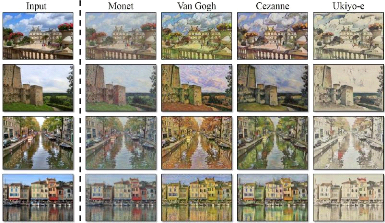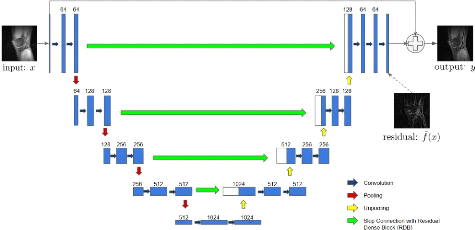Introduction
h Image to image Translation h The Unet
Model
h The Unet Generator Network
h The Markovian Discriminator h The Model Loss
Function h Conclusion
Definition 3.1
image to image translation is the controlled conversion
of an input image into a target image,image translation is a challenging task
that require a hand crafted lossfunction.[12]
?
3.1 Image to Image Translation

inspired by the language translation ,every scene can have
multiple representations such as grey scale,RGB, sketch etc the process of
translating an image into another domain is called style transfer 3.1
3.2 The U-net Model

Figure 3.1: style transfer / Source [25]

3.1.1 Pix2pix model
Definition 3.2
Pix2pix is GAN model designed for image to image
translation tasks,the architecture was proposed by Philip isola et al in their
2016 paper Image-to-image translation with conditional adversarial networks
[9],the pix2pix model is an implementation of the C-GAN where the generation of
the image is conditioned on a given image.
?
In the training process of Pix2pix model we give the
generator an image to condition the generation process. The output of the
generator is next fed to the discriminator along with the original image we fed
to the generator, next we provide the discriminator with a pair of real images(
original and target image) from the data set. The discriminator is suppose to
distinguish real pairs from fake pairs and the generator is suppose to fool the
discriminator hence the adversarial nature of the model.
· Note In a Pix2pix model exists
two loss functions,the adversarial loss and the L1 loss ,this way we don't only
force the generate to produce plausible images for the target domain ,but also
to generate images that are plausible as a transformation of the original
image.

L1 loss is the mean absolute difference between the
generated image and the expected image
Theorem 3.1
Xi= 1 i=n
|àyi - yi| (3.1)
?
22
23
3.2 The U-net Model
3.2 The U-net Model
First introduced by Philip isola et al in their paper
Image-to-image translation with conditional adversarial networks in 2016 [9]
,The U-net ?? is an implementation of the Pix2pix model where the generator in
a U-Net model and the discriminator is a Markovian discriminator also known as
a patch GAN ,this network proved superior performace on the image to image
translation tasks,
3.2.1 The Unet-Generator Model
U-Net is a model 3.2 first build for semantic segmentation.
It consists of a contracting path and an expansion path. The contracting path
is a typical architecture of a convolutional network. It consists of the
repeated application of two 3x3 convolutions, each followed by a ReLU and a 2x2
max pooling operation with stride 2 for downsampling. At each downsampling step
we double the number of feature channels. Every step in the expansive path
consists of an upsampling of the feature map followed by a 2x2 convolution that
halves the number of feature channels, a concatenation with the correspondingly
cropped feature map from the contracting path, and two 3x3 convolutions, each
followed by a ReLU. At the final layer a 1x1 convolution is used to map each
64-component feature vector to the desired number of classes. In total the
network has 23 convolutional layers. [1]

Figure 3.2: unet / Source[1]
· Note You can notice a similarity
between the U-net generator and a Encoder network ,the difference is the skip
connection between the down-sampling and the up-sampling layers. To gain
further intuition on why using a U-Net as a generator for an image to image
translation
| 


